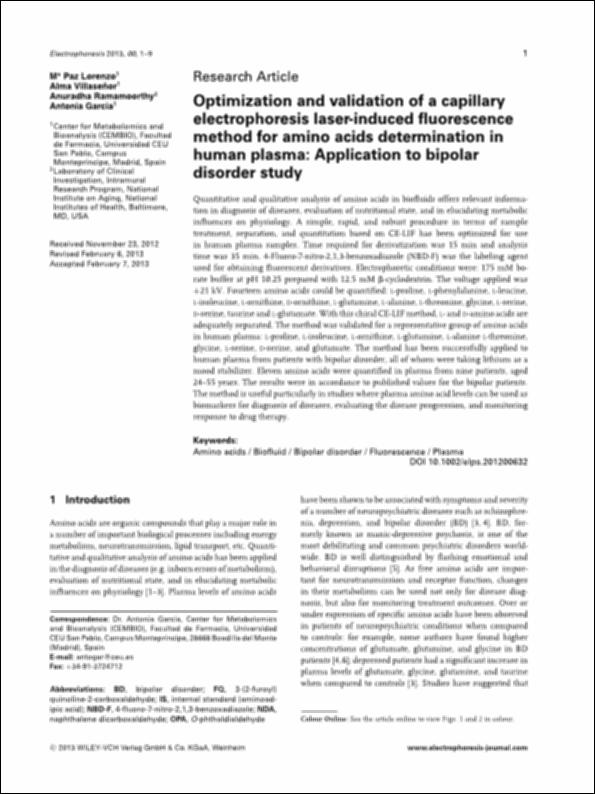Por favor, use este identificador para citar o enlazar este ítem:
http://hdl.handle.net/10637/12994Optimization and validation of a capillary electrophoresis laser-induced fluorescence method for amino acids determination in human plasma.
| Título : | Optimization and validation of a capillary electrophoresis laser-induced fluorescence method for amino acids determination in human plasma. |
| Autor : | Villaseñor Solis, Alma Cristina García Fernández, Antonia Lorenzo García, María Paz |
| Materias: | Amino acids.; Biofluid.; Bipolar disorder.; Fluorescence.; Plasma. |
| Resumen : | Quantitative and qualitative analysis of amino acids in biofluids offers relevant information in diagnosis of diseases, evaluation of nutritional state, and in elucidating metabolic influences on physiology. A simple, rapid, and robust procedure in terms of sample treatment, separation, and quantitation based on CE-LIF has been optimized for use in human plasma samples. Time required for derivatization was 15 min and analysis time was 35 min. 4-Fluoro-7-nitro-2,1,3-benzoxadiazole (NBD-F) was the labeling agent used for obtaining fluorescent derivatives. Electrophoretic conditions were: 175 mM borate buffer at pH 10.25 prepared with 12.5 mM -cyclodextrin. The voltage applied was +21 kV. Fourteen amino acids could be quantified: L-proline, L-phenylalanine, L-leucine, L-isoleucine, L-ornithine, D-ornithine, L-glutamine, L-alanine, L-threonine, glycine, L-serine, D-serine, taurine and L-glutamate. With this chiral CE-LIF method, L- and D-amino acids are adequately separated. The method was validated for a representative group of amino acids in human plasma: L-proline, L-isoleucine, L-ornithine, L-glutamine, L-alanine L-threonine, glycine, L-serine, D-serine, and glutamate. The method has been successfully applied to human plasma from patients with bipolar disorder, all of whom were taking lithium as a mood stabilizer. Eleven amino acids were quantified in plasma from nine patients, aged 24–55 years. The results were in accordance to published values for the bipolar patients. The method is useful particularly in studies where plasma amino acid levels can be used as biomarkers for diagnosis of diseases, evaluating the disease progression, and monitoring response to drug therapy. |
| Descripción : | Artículo en colaboración con: Ma Paz Lorenzo, Alma Villasenor, Anuradha Ramamoorthy, Antonia Garcia En: Electrophoresis. ISSN 0173-0835 2013, 34, 11: 1701 - 1709 |
| URI : | http://hdl.handle.net/10637/12994 |
| Derechos: | http://creativecommons.org/licenses/by-nc-nd/4.0/deed.es |
| Fecha de publicación : | 14-sep-2013 |
| Centro : | Universidad San Pablo-CEU |
| Aparece en las colecciones: | Facultad de Farmacia |
Los ítems de DSpace están protegidos por copyright, con todos los derechos reservados, a menos que se indique lo contrario.


